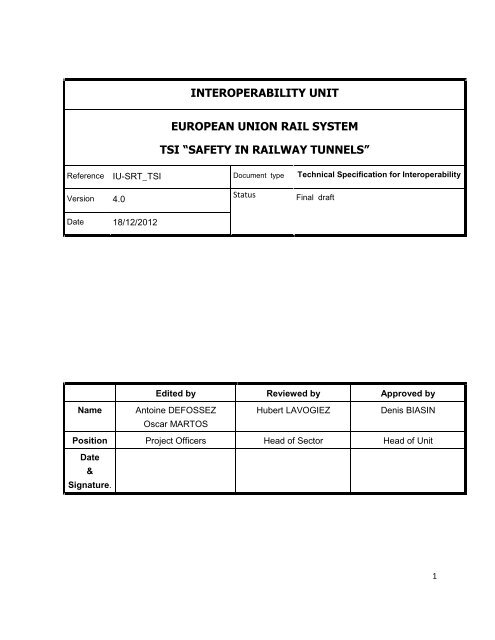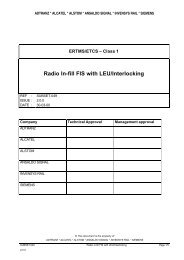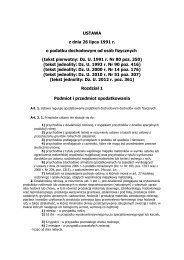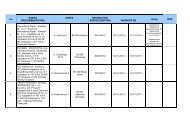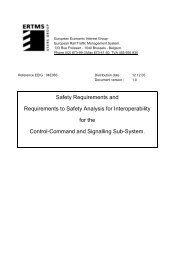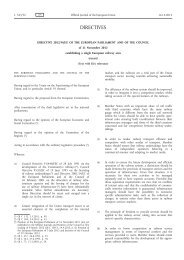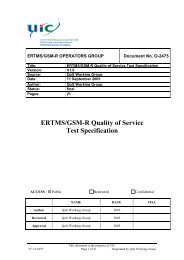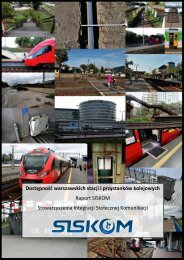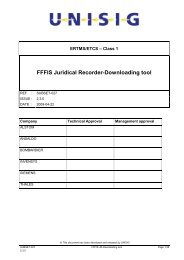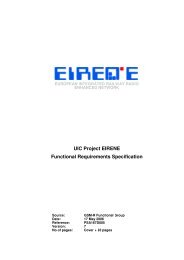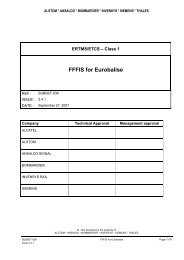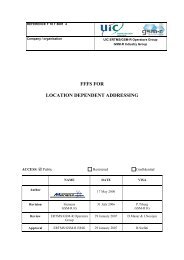safety in railway tunnels - ERA
safety in railway tunnels - ERA
safety in railway tunnels - ERA
Create successful ePaper yourself
Turn your PDF publications into a flip-book with our unique Google optimized e-Paper software.
INTEROP<strong>ERA</strong>BILITY UNITEUROPEAN UNION RAIL SYSTEMTSI “SAFETY IN RAILWAY TUNNELS”Reference IU-SRT_TSI Document type Technical Specification for InteroperabilityVersion 4.0StatusF<strong>in</strong>al draftDate 18/12/2012Edited by Reviewed by Approved byNameAnto<strong>in</strong>e DEFOSSEZHubert LAVOGIEZDenis BIASINOscar MARTOSPosition Project Officers Head of Sector Head of UnitDate&Signature.1
Amendment record:Date revision Modifications21/05/2012 1.0 Prelim<strong>in</strong>ary draft25/06/2012 2.0 Prelim<strong>in</strong>ary draft amended by SRT WP6 and CSG WP – version forexternal consultation16/11/2012 3.0 Prelim<strong>in</strong>ary draft amended by SRT WP7 and 8 – version for <strong>in</strong>ternalconsultation18/12/2012 4.0 F<strong>in</strong>al draft2
4.2.1. Subsystem Infrastructure .......................................................................................................... 154.2.2. Subsystem Energy ..................................................................................................................... 214.2.3. Subsystem roll<strong>in</strong>g stock ............................................................................................................. 224.3. Functional and technical specifications of the <strong>in</strong>terfaces ................................................................ 244.3.1. Interfaces with the Control-Command-Signall<strong>in</strong>g subsystem .................................................. 244.3.2. Interfaces with the Traffic Management and Operation subsystem ........................................ 244.4. Operat<strong>in</strong>g rules ................................................................................................................................ 254.4.1 Emergency rule .......................................................................................................................... 254.4.2 Tunnel emergency plan .............................................................................................................. 264.4.3 Exercises .................................................................................................................................... 264.4.4. Isolation and Earth<strong>in</strong>g procedures ............................................................................................ 264.4.5. Provision of on-tra<strong>in</strong> <strong>safety</strong> and emergency <strong>in</strong>formation to passengers ................................. 264.4.6. Operational rules related to tra<strong>in</strong>s runn<strong>in</strong>g <strong>in</strong> <strong>tunnels</strong> ............................................................. 274.5. Ma<strong>in</strong>tenance rules ........................................................................................................................... 274.5.1. Infrastructure ............................................................................................................................ 274.5.2. Ma<strong>in</strong>tenance of roll<strong>in</strong>g stock .................................................................................................... 284.6. Professional qualifications ............................................................................................................... 284.6.1. Tunnel specific competence of the tra<strong>in</strong> crew and other staff................................................. 284.7. Health and <strong>safety</strong> conditions ........................................................................................................... 284.7.1. Self-rescue device ..................................................................................................................... 284.8. Infrastructure and Roll<strong>in</strong>g stock registers ........................................................................................ 294.8.1. Register of <strong>in</strong>frastructure .......................................................................................................... 294.8.2. Roll<strong>in</strong>g Stock Register ................................................................................................................ 295. INTEROP<strong>ERA</strong>BILITY CONSTITUENTS ........................................................................................................ 294
6. ASSESSMENT OF CONFORMITY AND/OR SUITABILITY FOR USE OF THE CONSTITUENTS ANDVERIFICATION OF THE SUBSYSTEM ............................................................................................................. 296.1. Interoperability constituents ........................................................................................................... 296.2. Subsystems ...................................................................................................................................... 296.2.1. EC verification (general) ............................................................................................................ 296.2.2. Procedures for EC verification of a subsystem (modules) ........................................................ 306.2.3. Exist<strong>in</strong>g solutions ....................................................................................................................... 306.2.4. Innovative solutions .................................................................................................................. 306.2.5. Assessment of ma<strong>in</strong>tenance ..................................................................................................... 316.2.6. Assessment of operational rules ............................................................................................... 316.2.7. Additional requirements for assessment of specifications concern<strong>in</strong>g the IM ........................ 316.2.8. Additional requirements for assessment of specifications concern<strong>in</strong>g the RU ........................ 327. IMPLEMENTATION .................................................................................................................................. 327.1. Application of this TSI to new subsystems ....................................................................................... 337.1.1. General ...................................................................................................................................... 337.1.2. New roll<strong>in</strong>g stock ....................................................................................................................... 337.1.3 New Infrastructure ..................................................................................................................... 337.2. Application of this TSI to subsystems already <strong>in</strong> service ................................................................. 337.2.1. Upgrade or renewal of roll<strong>in</strong>g stock ......................................................................................... 337.2.2. Upgrade and renewal measures for <strong>tunnels</strong> ............................................................................ 337.2.3. Operations subsystem .............................................................................................................. 337.2.4. Operation of new roll<strong>in</strong>g stock <strong>in</strong> exist<strong>in</strong>g <strong>tunnels</strong> ................................................................... 347.3. Specific cases .................................................................................................................................... 347.3.1. General ...................................................................................................................................... 347.3.2 Operational rules related to tra<strong>in</strong>s runn<strong>in</strong>g <strong>in</strong> <strong>tunnels</strong> (clause 4.4.6) ........................................ 345
APPENDIX A STANDARDS OR NORMATIVE DOCUMENTS REFERRED TO IN THIS TSI .............................. 35APPENDIX B ASSESSMENT OF THE SUBSYSTEMS .................................................................................... 366
1. INTRODUCTION1.1. Technical scope(a) This TSI concerns the follow<strong>in</strong>g subsystems as def<strong>in</strong>ed <strong>in</strong> Directive 2008/57/EC 1 : <strong>in</strong>frastructure (‘INF’),energy (‘ENE’), operation (‘OPE’), roll<strong>in</strong>g stock (locomotives and passenger units ‘LOC&PAS’) andControl-Command and Signall<strong>in</strong>g (‘CCS’).(b) The purpose of this TSI is to def<strong>in</strong>e a coherent set of tunnel specific measures for the <strong>in</strong>frastructure,energy, roll<strong>in</strong>g stock, control-command and signall<strong>in</strong>g and operation subsystems, thus deliver<strong>in</strong>g anoptimal level of <strong>safety</strong> <strong>in</strong> <strong>tunnels</strong> <strong>in</strong> the most cost-efficient way.(c) It shall permit free movement of vehicles which are <strong>in</strong> compliance with this TSI to run underharmonised <strong>safety</strong> conditions <strong>in</strong> <strong>railway</strong> <strong>tunnels</strong>.(d) Only specific measures, designed to reduce specific tunnel risks, are prescribed <strong>in</strong> the present TSI.Risks related to pure <strong>railway</strong> operation, such as derailment and collision with other tra<strong>in</strong>s, are addressedby general <strong>railway</strong> <strong>safety</strong> measures.(e) In case the application of the present TSI would lead to a decrease of the system <strong>safety</strong> level,Member States can reta<strong>in</strong> more str<strong>in</strong>gent requirements <strong>in</strong> accordance with Directive 2004/49/EC 2 Art 8,as long as these requirements do not prevent the operation of TSI compliant tra<strong>in</strong>s. Such requirementsshall be notified to the Commission before they are <strong>in</strong>troduced. Such higher requirements must bebased on a risk analysis and must be justified by a particular risk situation. They shall be the result of aconsultation of the Infrastructure Manager and of the relevant authorities for rescue, and they shall besubject to a cost-benefit assessment.1.1.1. Scope related to <strong>tunnels</strong>(a) This TSI applies to new, renewed and upgraded <strong>tunnels</strong> which are located on the European Union railnetwork, and which are <strong>in</strong> accordance with the def<strong>in</strong>ition <strong>in</strong> clause 2.4 of this TSI.(b) Stations that are <strong>in</strong> <strong>tunnels</strong> shall be <strong>in</strong> conformity with the national rules on fire <strong>safety</strong>. When theyare used as safe areas or fire fight<strong>in</strong>g po<strong>in</strong>ts, they shall comply with the specifications <strong>in</strong> this TSI.1.1.2. Scope related to roll<strong>in</strong>g stock(a) This TSI applies to roll<strong>in</strong>g stock which is <strong>in</strong> the scope of the LOC&PAS TSI.1 Directive 2008/57/EC of the European Parliament and of the Council of 17 June 2008 on the <strong>in</strong>teroperability ofthe rail system with<strong>in</strong> the Community (OJ L 191, 18.7.2008, p. 1)2 Directive 2004/49/EC of the European Parliament and of the Council of 29 April 2004 on <strong>safety</strong> on theCommunity's <strong>railway</strong>s (OJ L 164, 30.4.2004, p. 44)7
(b) Roll<strong>in</strong>g stock categorised “A” or “B” accord<strong>in</strong>g to the previous SRT TSI 3 shall reta<strong>in</strong> its category <strong>in</strong> thisTSI as def<strong>in</strong>ed <strong>in</strong> clause 4.2.3.1.1.3 Scope related to operational aspects(a) This TSI applies to the operation of all units of roll<strong>in</strong>g stock which are runn<strong>in</strong>g <strong>in</strong> <strong>tunnels</strong> described <strong>in</strong>clause 1.1.1.1.1.3.1. Operation of freight tra<strong>in</strong>s(a) When each vehicle of a freight tra<strong>in</strong> or dangerous good tra<strong>in</strong> as def<strong>in</strong>ed <strong>in</strong> clause 2.4 complies withthe structural TSIs which apply to it (LOC&PAS, SRT, NOI, CCS, WAG) and when the dangerous goodswagon(s) complies with the Annex II of Directive 2008/68/EC 4 , the freight tra<strong>in</strong> or dangerous good tra<strong>in</strong>operated accord<strong>in</strong>g to the requirements of the OPE TSI shall be allowed to circulate <strong>in</strong> all <strong>tunnels</strong> of theEuropean Union rail system.1.1.4. Risk scope, risks that are not covered by this TSI(a) This TSI covers only specific risks to the <strong>safety</strong> of passengers and on-board staff <strong>in</strong> <strong>tunnels</strong> for thesubsystems above. It also covers risks for the people <strong>in</strong> the neighbourhood of a tunnel where a collapseof the structure could have catastrophic consequences.(b) Where the risk analysis comes to the conclusion that other scenarios might be of relevance, specificmeasures to deal with these scenarios have to be def<strong>in</strong>ed(c)Risks not covered by this TSI are as follows:(1) Health and <strong>safety</strong> of staff <strong>in</strong>volved <strong>in</strong> the ma<strong>in</strong>tenance of the fixed <strong>in</strong>stallations <strong>in</strong> <strong>tunnels</strong>.(2) F<strong>in</strong>ancial loss due to damage to structures and tra<strong>in</strong>s, and consequently the losses result<strong>in</strong>gfrom non-availability of the tunnel for repairs.(3) Trespass <strong>in</strong>to the tunnel through the tunnel portals.(4) Terrorism, as a deliberate and premeditated act which is designed to cause wantondestruction, <strong>in</strong>jury and loss of life.1.2. Geographical scope(a) The geographical scope of this TSI is the network of the whole rail system, composed of:3 Commission Decision 2008/163/EC of 20 December 2007 concern<strong>in</strong>g the technical specification of<strong>in</strong>teroperability relat<strong>in</strong>g to the ‘<strong>safety</strong> <strong>in</strong> <strong>railway</strong> <strong>tunnels</strong>’ <strong>in</strong> the trans-European conventional and high-speed railsystem (OJ L 64, 07.03.2008, p. 1).4 Directive 2008/68/EC of the European Parliament and of the Council of 24 September 2008 on the <strong>in</strong>landtransport of dangerous goods (OJ L 260, 30.9.2008, p. 13–59 ).8
The trans-European conventional rail system network (TEN) as described <strong>in</strong> Annex I section1.1 “Network” of Directive 2008/57/EC The trans-European high-speed rail system network (TEN) as described <strong>in</strong> Annex I section 2.1“Network” of Directive 2008/57/ECOther parts of the network of the whole rail system, follow<strong>in</strong>g the extension of scope asdescribed <strong>in</strong> Annex I section 4 of Directive 2008/57/EC,and excludes the cases referred to <strong>in</strong> Article 1(3) of Directive 2008/57/EC.2. DEFINITION OF ASPECT/SCOPE2.1. General(a) The l<strong>in</strong>e of defence for the promotion of <strong>safety</strong> <strong>in</strong> <strong>tunnels</strong> comprises four successive layers:Prevention, mitigation, evacuation and rescue.(b) The largest contribution is <strong>in</strong> the area of prevention followed by mitigation and so on.(c) The layers of <strong>safety</strong> comb<strong>in</strong>e to produce a low level of residual risk.9
(d) A major feature of <strong>railway</strong>s is their <strong>in</strong>herent ability to prevent accidents through the traffic runn<strong>in</strong>gon a guide-way and be<strong>in</strong>g usually controlled and regulated us<strong>in</strong>g a signall<strong>in</strong>g system.2.2. The risk scenarios(a) This TSI provides measures which could offset or mitigate the difficulty of evacuation or rescueoperations follow<strong>in</strong>g a <strong>railway</strong> <strong>in</strong>cident.(b) Relevant measures have been identified, which will suppress or significantly reduce the risks aris<strong>in</strong>gfrom these scenarios.(c) They have been developed, <strong>in</strong> the categories prevention/mitigation/evacuation/rescue; howeverthey do not appear under these head<strong>in</strong>gs <strong>in</strong> this TSI but under the head<strong>in</strong>gs of the concernedsubsystems.(d) The measures prescribed can be considered as a response to the follow<strong>in</strong>g three types of <strong>in</strong>cidents2.2.1. ‘Hot’ <strong>in</strong>cidents: Fire, explosion followed by fire, emission of toxic smoke or gases.(a) The ma<strong>in</strong> danger is fire. Fire is understood as a comb<strong>in</strong>ation of heat, flames and smoke.(b) The fire starts on a tra<strong>in</strong>.10
The fire is detected, either by on-board fire detectors, or by persons on-board. The driver isnotified of a problem, either that there is a fire by an automatic notification or that there is aproblem <strong>in</strong> general by passengers us<strong>in</strong>g the passenger alarm.The driver is <strong>in</strong>structed to act appropriately depend<strong>in</strong>g on the local circumstances.Ventilation is shut down to prevent smoke distribution. For roll<strong>in</strong>g stock of category B, thepassengers <strong>in</strong> the affected area will move to a non-affected area of the tra<strong>in</strong> where they areprotected from fire and fumesWhenever possible the tra<strong>in</strong> leaves the tunnel. If appropriate, the tra<strong>in</strong> may stop at a firefight<strong>in</strong>g po<strong>in</strong>t <strong>in</strong>side the tunnel.Passengers are evacuated, directed by the tra<strong>in</strong> crew, or by self-rescue, to a safe area.On roll<strong>in</strong>g stock of category B which architecture does not permit a full redundancy of tractionequipment, the fire ext<strong>in</strong>guish<strong>in</strong>g system will ext<strong>in</strong>guish the fire after which the <strong>in</strong>cident willbecome a ‘cold’ <strong>in</strong>cident.(c) The fire starts <strong>in</strong> the tunnel.If fire starts <strong>in</strong> a tunnel or <strong>in</strong> a technical room, the driver is <strong>in</strong>structed to act appropriatelydepend<strong>in</strong>g on the local circumstances <strong>in</strong> compliance with the emergency scenarios, described <strong>in</strong>the Emergency Plan.2.2.2. ‘Cold’ <strong>in</strong>cidents: collision, derailment(a) The tunnel specific measures concentrate on access/egress facilities to support evacuation and the<strong>in</strong>tervention of rescue forces.(b) The difference with the hot scenarios is that there is no time constra<strong>in</strong>t due to the presence of ahostile environment created by a fire.2.2.3. Prolonged stop(a) Prolonged stop (an unplanned stop <strong>in</strong> a tunnel, without occurrence of a hot or cold <strong>in</strong>cident, forlonger than 10 m<strong>in</strong>utes) is not by itself a threat to passengers and staff.(b) However it may lead to panic and to spontaneous, uncontrolled evacuation that exposes people todangers present <strong>in</strong> a tunnel environment.2.2.4. Exclusions(a) The scenarios that have not been dealt with are listed <strong>in</strong> clause 1.1.4.2.3. The role of emergency response services(a) The def<strong>in</strong>ition of the role of the emergency response services is a matter for the relevant nationallegislation.11
(c) Fire fight<strong>in</strong>g po<strong>in</strong>t: a fire fight<strong>in</strong>g po<strong>in</strong>t is a def<strong>in</strong>ed location, <strong>in</strong>side or outside the tunnel, where firefight<strong>in</strong>g equipment can be used by rescue services and where passengers and staff can evacuate.(d) Technical rooms: Technical rooms are enclosed spaces with doors for access/egress <strong>in</strong>side or outsidethe tunnel with <strong>safety</strong> <strong>in</strong>stallations which are necessary for at least one of the follow<strong>in</strong>g functions: selfrescue,evacuation, emergency communication, rescue and fire fight<strong>in</strong>g, signall<strong>in</strong>g and communicationequipment, and traction power supply.(e) Freight tra<strong>in</strong>: A freight tra<strong>in</strong> is a tra<strong>in</strong> composed of one or more locomotive(s) and one or morewagon(s). A freight tra<strong>in</strong> <strong>in</strong>clud<strong>in</strong>g at least one wagon carry<strong>in</strong>g dangerous goods is a dangerous goodstra<strong>in</strong>.(f) All other def<strong>in</strong>itions related to roll<strong>in</strong>g stock are def<strong>in</strong>ed <strong>in</strong> the LOC&PAS TSI and WAG TSI.3. ESSENTIAL REQUIREMENTSThe follow<strong>in</strong>g table <strong>in</strong>dicates basic parameters of this TSI and their correspondence to the essentialrequirements as set out and numbered <strong>in</strong> Annex III to Directive 2008/57/EC.Element of the<strong>in</strong>frastructure sub-systemRef. Clause Safety ReliabilityAvailabilityHealthEnvironmentalprotectionTechnicalcompatibilityPrevent unauthorisedaccess to emergencyexits and technicalrooms4.2.1.1. 2.1.1Fire resistance oftunnel structures4.2.1.2. 1.1.42.1.1Fire reaction ofbuild<strong>in</strong>g material4.2.1.3. 1.1.42.1.11.3.2 1.4.2Fire detection 4.2.1.4. 1.1.42.1.1Evacuation facilities 4.2.1.5. 1.1.52.1.1Escape walkways 4.2.1.6. 2.1.1Fire fight<strong>in</strong>g po<strong>in</strong>ts 4.2.1.7. 2.1.1 1.5Emergencycommunication4.2.1.8. 2.1.113
Element of the energysub-systemRef. Clause Safety ReliabilityAvailabilityHealthEnvironmentalprotectionTechnicalcompatibilitySegmentation ofoverhead l<strong>in</strong>e orconductor rails4.2.2.1. 2.2.1Overhead l<strong>in</strong>e orconductor rail earth<strong>in</strong>g4.2.2.2. 2.2.1Electricity supply 4.2.2.3. 2.2.1Requirements forelectrical cables <strong>in</strong><strong>tunnels</strong>4.2.2.4. 2.2.11.1.41.3.2 1.4.2Reliability of electrical<strong>in</strong>stallations4.2.2.5. 2.2.1Element of the roll<strong>in</strong>gstock sub-systemRef. Clause Safety ReliabilityAvailabilityHealthEnvironmentalprotectionTechnicalcompatibilityMeasures to preventfire4.2.3.1 1.1.42.4.11.3.2 1.4.2Measures to detectand control fire4.2.3.2 1.1.42.4.1Requirements relatedto emergenciesRequirements relatedto evacuation4.2.3.3 2.4.1 2.4.2 1.52.4.34.2.3.4 2.4.14. CHARACTERISATION OF THE SUBSYSTEM4.1. Introduction(a) The European Union rail system, to which Directive 2008/57/EC applies and of which the subsystemsare parts, is developed to become an <strong>in</strong>tegrated system for which the consistency must be verified.14
(b) This consistency has been checked <strong>in</strong> relation to the development of the specifications with<strong>in</strong> thisTSI, its <strong>in</strong>terfaces with respect to the systems <strong>in</strong> which it is <strong>in</strong>tegrated and also the operat<strong>in</strong>g rules forthe <strong>railway</strong>.(c) Tak<strong>in</strong>g account of all the applicable essential requirements, the basic parameters related to <strong>safety</strong> <strong>in</strong><strong>railway</strong> <strong>tunnels</strong> are set out for the subsystems <strong>in</strong>frastructure, energy and roll<strong>in</strong>g stock <strong>in</strong> section 4.2 ofthis TSI. The operational requirements and responsibilities are set out <strong>in</strong> the OPE TSI and <strong>in</strong> section 4.4of this TSI.4.2. Functional and technical specifications of the subsystems(a) In the light of the essential requirements <strong>in</strong> Chapter 3, the functional and technical specifications ofthose aspects specific to tunnel <strong>safety</strong> <strong>in</strong> the above-mentioned subsystems are as follows:4.2.1. Subsystem Infrastructure4.2.1.1. Prevent unauthorised access to emergency exits and technical roomsThis specification applies to all <strong>tunnels</strong>.(a) Unauthorised access to technical rooms shall be prevented.(b) Where emergency exits are locked for security purposes, it shall always be possible to open themfrom <strong>in</strong>side.4.2.1.2. Fire resistance of tunnel structuresThis specification applies to all <strong>tunnels</strong>.(a) In the event of fire, the <strong>in</strong>tegrity of the tunnel l<strong>in</strong><strong>in</strong>g shall be ma<strong>in</strong>ta<strong>in</strong>ed for a period of timesufficiently long to permit self-rescue, evacuation of passengers and staff and <strong>in</strong>tervention of emergencyresponse services. That period of time shall be <strong>in</strong> accordance with the evacuation scenario and reported<strong>in</strong> the Emergency Plan.(b) In the cases of immersed <strong>tunnels</strong> and <strong>tunnels</strong> which can cause the collapse of importantneighbour<strong>in</strong>g structures, the tunnel ma<strong>in</strong> structure shall withstand the temperature of the fire for aperiod of time allow<strong>in</strong>g evacuation of the endangered tunnel zones and neighbour<strong>in</strong>g structures. Thisperiod of time shall be reported <strong>in</strong> the emergency plan.4.2.1.3. Fire reaction of build<strong>in</strong>g materialThis specification applies to all <strong>tunnels</strong>.(a) This specification applies to construction products and build<strong>in</strong>g elements <strong>in</strong>side <strong>tunnels</strong>.15
(b) Tunnel build<strong>in</strong>g material shall fulfil the requirements of classification A2 of Commission Decision2000/147/EC 5 . Non-structural panels and other equipment shall fulfil the requirements of classificationB of Commission Decision 2000/147/EC.(c) Materials that would not contribute significantly to a fire load shall be listed. They are allowed not tocomply with the above.4.2.1.4. Fire detection <strong>in</strong> technical roomsThis specification applies to all <strong>tunnels</strong> of more than 1 km <strong>in</strong> length.(a) Technical rooms shall be equipped with detectors which alert the <strong>in</strong>frastructure manager <strong>in</strong> case offire.4.2.1.5. Evacuation facilities4.2.1.5.1 Safe areaThis specification applies to all <strong>tunnels</strong> of more than 1 km <strong>in</strong> length.(a) A safe area shall allow the evacuation of tra<strong>in</strong>s that use the tunnel. It shall have a capacitycorrespond<strong>in</strong>g to the maximum capacity of the tra<strong>in</strong>s planned to be operated on the l<strong>in</strong>e where thetunnel is located.(b) The safe area shall ma<strong>in</strong>ta<strong>in</strong> survivable conditions for passengers and staff dur<strong>in</strong>g the time neededfor the complete evacuation from the safe area to a f<strong>in</strong>al place of <strong>safety</strong>.(c) In case of underground/ undersea safe areas, the provisions shall allow people to move from the safearea to the surface without hav<strong>in</strong>g to re-enter the affected tunnel tube.(d) The lay-out of an underground safe area and its equipment shall take <strong>in</strong>to account the control ofsmoke, <strong>in</strong> particular to protect people who use the self-evacuation facilities.4.2.1.5.2 Access to the safe areaThis specification applies to all <strong>tunnels</strong> of more than 1 km <strong>in</strong> length.(a) Safe areas shall be accessible for people who commence self-evacuation from the tra<strong>in</strong> as well as foremergency response services.(b) One of the follow<strong>in</strong>g solutions shall be selected for access po<strong>in</strong>ts from a tra<strong>in</strong> to the safe areas:(1) Lateral and/or vertical emergency exits to the surface. These exits shall be provided at leastevery 1 000 m.5 Commission Decision 2000/147/EC of 8 February 2000 implement<strong>in</strong>g Council Directive 89/106/EEC as regards theclassification of the reaction to fire performance of construction products (OJ L 50, 23.2.2000, p. 14–18).16
(2) Cross-passages between adjacent <strong>in</strong>dependent tunnel tubes, which enable the adjacenttunnel tube to be employed as a safe area. Cross-passages shall be provided at least every 500m.(3) Alternative technical solutions provid<strong>in</strong>g a safe area with a m<strong>in</strong>imum equivalent <strong>safety</strong> levelare permitted. The equivalent level of <strong>safety</strong> to passengers and staff shall be demonstratedus<strong>in</strong>g the Common Safety Methods on risk assessment 6 .(c) Doors giv<strong>in</strong>g access from the escape walkway to the safe area shall have a m<strong>in</strong>imum clear open<strong>in</strong>g of1,4m wide and 2,0m high, alternatively it is permitted to use multiple doors next to each other whichare less wide as long as the flow capacity of people is demonstrated to be equivalent or higher.(d) After pass<strong>in</strong>g the doors, the clear width shall cont<strong>in</strong>ue to be at least 1,5m wide and 2,25m high.(e) The way the emergency response services access the safe area shall be described <strong>in</strong> the emergencyplan.4.2.1.5.3 Communication means <strong>in</strong> safe areasThis specification applies to all <strong>tunnels</strong> of more than 1 km <strong>in</strong> length.(a) Communication shall be possible, either by mobile phone or by fixed connection from undergroundsafe areas to the control centre of the Infrastructure Manager.4.2.1.5.4 Emergency light<strong>in</strong>g on escape routesThis specification applies to all <strong>tunnels</strong> of more than 0,5 km <strong>in</strong> length.(a) Emergency light<strong>in</strong>g shall be provided to guide passengers and staff to a safe area <strong>in</strong> the event of anemergency.(b) Illum<strong>in</strong>ation shall comply with the follow<strong>in</strong>g requirements:(1) S<strong>in</strong>gle-track tube: at least on the side of the walkway(2) Multiple-track tube: on both sides of the tube(3) Position of lights:• above the walkway, as low as possible, so as not to <strong>in</strong>terfere with the free spacefor the passage of persons, or• built <strong>in</strong>to the handrails.6 Commission Regulation (EC) No 352/2009 of 24 April 2009 on the adoption of a common <strong>safety</strong> method on riskevaluation and assessment as referred to <strong>in</strong> Article 6(3)(a) of Directive 2004/49/EC of the European Parliament andof the Council (OJ L 108, 29.4.2009, p 4).17
(4) The ma<strong>in</strong>ta<strong>in</strong>ed illum<strong>in</strong>ance shall be at least 1 lux at a horizontal plane at walkway level.(c) Autonomy and reliability: an alternative power supply shall be available for an appropriate period oftime after failure of the ma<strong>in</strong> power supply.. The time required shall be consistent with the evacuationscenarios and reported <strong>in</strong> the Emergency Plan.(d) If the emergency light is switched off under normal operat<strong>in</strong>g conditions, it shall be possible toswitch it on by both of the follow<strong>in</strong>g means:(1) manually from <strong>in</strong>side the tunnel at <strong>in</strong>tervals of 250 m(2) by the tunnel operator us<strong>in</strong>g remote control4.2.1.5.5 Escape signageThis specification applies to all <strong>tunnels</strong>.(a) The escape signage <strong>in</strong>dicates the emergency exits, the distance and the direction to a safe area.(b) All signs shall be designed accord<strong>in</strong>g to the requirements of Directive 92/58/EC of 24 June 1992concern<strong>in</strong>g the provision of health and/or <strong>safety</strong> signs at work 7 and to the specification referenced <strong>in</strong>appendix A, <strong>in</strong>dex 1.(c) Escape signs shall be <strong>in</strong>stalled on sidewalls along escape walkways.(d) The maximum distance between escape signs shall be 50 m.(e) Signs shall be provided <strong>in</strong> the tunnel to <strong>in</strong>dicate the position of emergency equipment, where suchequipment is present.(f) All doors lead<strong>in</strong>g to emergency exits or cross-passage shall be marked.4.2.1.6. Escape walkwaysThis specification applies to all <strong>tunnels</strong> of more than 0,5 km <strong>in</strong> length.(a) Walkways shall be constructed <strong>in</strong> a s<strong>in</strong>gle track tunnel tube on at least one side of the track and <strong>in</strong> amultiple track tunnel tubes on both sides of the tunnel tube. In tunnel tubes with more than two tracks,access to a walkway shall be possible from each track.(1) The width of the walkway shall be at least 0.8 m.(2) The m<strong>in</strong>imum vertical clearance above the walkway shall be 2.25m.(3) The height of the walkway shall be at top-of-rail level or higher.7 OJ L 245, 26.8.1992, p. 23–42.18
(4) Local constrictions caused by obstacles <strong>in</strong> the escape area shall be avoided. The presence ofobstacles shall not reduce the m<strong>in</strong>imum width to less than 0,7 m, and the length of the obstacleshall not exceed 2 m.(b) Cont<strong>in</strong>uous handrails shall be <strong>in</strong>stalled between 0.8m and 1.1m above walkway provid<strong>in</strong>g a route toa safe area.(1) Handrails shall be placed outside the required m<strong>in</strong>imum clearance of the walkway.(2) Handrails shall be angled at 30 o to 40 o to the longitud<strong>in</strong>al axis of the tunnel at the entranceto and exit from an obstacle.4.2.1.7 Fire fight<strong>in</strong>g po<strong>in</strong>tsThis specification applies to all <strong>tunnels</strong> of more than 1 km <strong>in</strong> length.(a) For the purpose of that clause, two or more consecutive <strong>tunnels</strong> will be considered as a s<strong>in</strong>gle tunnelunless both follow<strong>in</strong>g conditions are met:(1) The separation between <strong>tunnels</strong> <strong>in</strong> open air is longer than the maximum length of the tra<strong>in</strong><strong>in</strong>tended to be operated on the l<strong>in</strong>e + 100 m and(2) The open air area around the separation is sufficiently large to allow passengers to move to asafe location(b) Fire fight<strong>in</strong>g po<strong>in</strong>ts shall be created(1)Outside both portals of every tunnel of >1km and(2) Inside the tunnel, accord<strong>in</strong>g to the category of roll<strong>in</strong>g stock that is planned to be operated, assummarized <strong>in</strong> the table below:Tunnel lengthRoll<strong>in</strong>g stock category accord<strong>in</strong>gto paragraph 4.2.3Maximum distance from theportals to a fire fight<strong>in</strong>g po<strong>in</strong>t andbetween fire fight<strong>in</strong>g po<strong>in</strong>ts1 to 5 km Category A or B No fire fight<strong>in</strong>g po<strong>in</strong>t required5 to 20 km Category A 5 km5 to 20 km Category B No fire fight<strong>in</strong>g po<strong>in</strong>t required>20 km Category A 5 kmThis case is only acceptable whenthe fire fight<strong>in</strong>g po<strong>in</strong>ts are19
20 km Category B 20 km(c) Requirements for all fire fight<strong>in</strong>g po<strong>in</strong>ts:underground passenger stations(1) The fire fight<strong>in</strong>g po<strong>in</strong>ts shall be equipped with water supply (m<strong>in</strong>imum 800l/m<strong>in</strong> dur<strong>in</strong>g 2hours) close to the <strong>in</strong>tended stopp<strong>in</strong>g po<strong>in</strong>t of the tra<strong>in</strong>. The method of supply<strong>in</strong>g the water shallbe described <strong>in</strong> the emergency plan.(2) The <strong>in</strong>tended stopp<strong>in</strong>g position of the affected tra<strong>in</strong> shall be <strong>in</strong>dicated to the tra<strong>in</strong> driver. Thisshall not require specific on-board equipment (all TSI compliant tra<strong>in</strong>s must be able to use thetunnel)(3) The fire fight<strong>in</strong>g po<strong>in</strong>ts shall be accessible to emergency response services. The way theemergency response services access the fire fight<strong>in</strong>g po<strong>in</strong>t and deploy equipment shall bedescribed <strong>in</strong> the emergency plan.(4) It shall be possible to switch off the traction energy supply and earth the electrical<strong>in</strong>stallation at fire fight<strong>in</strong>g po<strong>in</strong>ts.(d) Requirements for fire fight<strong>in</strong>g po<strong>in</strong>ts outside the portals of the tunnelIn addition to requirements <strong>in</strong> 4.2.1.7 (c), fire fight<strong>in</strong>g po<strong>in</strong>ts outside the portals of the tunnel shallcomply with the follow<strong>in</strong>g requirements:(1) The open air area around the fire fight<strong>in</strong>g po<strong>in</strong>t shall offer a m<strong>in</strong>imum surface of 500 m².(e) Requirements for fire fight<strong>in</strong>g po<strong>in</strong>ts <strong>in</strong>side the tunnelIn addition to requirements <strong>in</strong> 4.2.1.7 (c), fire fight<strong>in</strong>g po<strong>in</strong>ts <strong>in</strong>side the tunnel shall comply with thefollow<strong>in</strong>g requirements(1) A safe area shall be accessible from the stopp<strong>in</strong>g position of the tra<strong>in</strong>. Dimensions of theevacuation route to the safe area shall consider the evacuation time (as specified <strong>in</strong> clause4.2.3.4.1) and the planned capacity of the tra<strong>in</strong>s (referred to <strong>in</strong> clause 4.2.1.5.1) <strong>in</strong>tended to beoperated <strong>in</strong> the tunnel. The adequacy of the siz<strong>in</strong>g of the evacuation route shall bedemonstrated.(2) The safe area that is paired with the fire fight<strong>in</strong>g po<strong>in</strong>t shall offer a sufficient stand<strong>in</strong>g surfacerelatively to the time passengers are expected to wait until they are evacuated to a f<strong>in</strong>al place of<strong>safety</strong>.(3) There shall be an access to the affected tra<strong>in</strong> for emergency response services without go<strong>in</strong>gthrough the occupied safe area.20
(4) The lay-out of the fire fight<strong>in</strong>g po<strong>in</strong>t and its equipment shall take <strong>in</strong>to account the control ofsmoke, <strong>in</strong> particular to protect people who use the self-evacuation facilities to access the safearea.4.2.1.8 Emergency communicationThis specification applies to all <strong>tunnels</strong> of more than 1 km <strong>in</strong> length.(a) Radio communication between the tra<strong>in</strong> and the <strong>in</strong>frastructure manager control centre shall beprovided <strong>in</strong> each tunnel with GSM-R.(b) Radio cont<strong>in</strong>uity shall be provided for permitt<strong>in</strong>g the emergency response services to communicatewith their on-site command facilities. The system shall allow the emergency response services to usetheir own communication equipment.4.2.2. Subsystem EnergyThis section applies to the <strong>in</strong>frastructure part of the subsystem Energy.4.2.2.1. Segmentation of overhead l<strong>in</strong>e or conductor railsThis specification applies to <strong>tunnels</strong> of more than 5 km <strong>in</strong> length.(a) The traction energy supply system <strong>in</strong> <strong>tunnels</strong> shall be divided up <strong>in</strong>to sections, each not exceed<strong>in</strong>g 5km. This specification applies only if the signall<strong>in</strong>g system permits the presence of more than one tra<strong>in</strong> <strong>in</strong>the tunnel on each track simultaneously.(b) The location of the switches shall be arranged so that the number of switches <strong>in</strong> the tunnel ism<strong>in</strong>imised.(c) Remote control and switch<strong>in</strong>g of each ‘switch<strong>in</strong>g section’ shall be provided.(d) A means of communication and light<strong>in</strong>g shall be provided at the switch<strong>in</strong>g location to enable safemanual operation and ma<strong>in</strong>tenance of the switch<strong>in</strong>g equipment.4.2.2.2. Overhead l<strong>in</strong>e or conductor rail earth<strong>in</strong>gThis specification applies to all <strong>tunnels</strong> of more than 1 km length.(a) Earth<strong>in</strong>g devices shall be provided at tunnel access po<strong>in</strong>ts and, if the earth<strong>in</strong>g procedures allow theearth<strong>in</strong>g of a s<strong>in</strong>gle section, close to the separation po<strong>in</strong>ts between sections. These shall be eithermanually or remotely controlled fixed <strong>in</strong>stallations.(b) Communication and light<strong>in</strong>g means necessary for earth<strong>in</strong>g operations shall be provided.(c) Procedures and responsibilities for earth<strong>in</strong>g shall be def<strong>in</strong>ed between the Infrastructure Managerand the emergency response services, based on the emergency scenarios considered with<strong>in</strong> theemergency plan.21
4.2.2.3. Electricity supplyThis specification applies to all <strong>tunnels</strong> of more than 1 km length.(a) The electricity power distribution system <strong>in</strong> the tunnel shall be suitable for emergency responseservices equipment <strong>in</strong> accordance with the emergency plan for the tunnel. (Some national emergencyresponse services groups may be self-sufficient <strong>in</strong> relation to power supply. In this case, the option ofnot provid<strong>in</strong>g power supply facilities for the use of such groups may be appropriate. Such a decision,however, must be described <strong>in</strong> the emergency plan.)4.2.2.4. Requirements for electrical cables <strong>in</strong> <strong>tunnels</strong>This specification applies to all <strong>tunnels</strong> of more than 1 km length.(a) In case of fire, exposed cables shall have the characteristics of low flammability, low fire spread, lowtoxicity and low smoke density. These requirements are fulfilled when the cables fulfil as a m<strong>in</strong>imum therequirements of classification B2 CA , s1a, a1, as per Commission Decision 2006/751/EC 8 .4.2.2.5. Reliability of electrical <strong>in</strong>stallationsThis specification applies to all <strong>tunnels</strong> of more than 1 km length.(a) Electrical <strong>in</strong>stallations relevant for <strong>safety</strong> (Fire detection, emergency light<strong>in</strong>g, emergencycommunication and any other system identified by the Infrastructure Manager or contract<strong>in</strong>g entity asvital to the <strong>safety</strong> of passengers <strong>in</strong> the tunnel) shall be protected aga<strong>in</strong>st damage aris<strong>in</strong>g frommechanical impact, heat or fire.(b) The distribution system shall be designed to enable the system to tolerate unavoidable damage by(for example) energiz<strong>in</strong>g alternative l<strong>in</strong>ks.(c) Autonomy and reliability: an alternative power supply shall be available for an appropriate period oftime after failure of the ma<strong>in</strong> power supply. The time required shall be consistent with the evacuationscenarios and reported <strong>in</strong> the Emergency Plan.4.2.3. Subsystem roll<strong>in</strong>g stock(a) In the context of this TSI the subsystem roll<strong>in</strong>g stock is subdivided <strong>in</strong>to the follow<strong>in</strong>g categories.(1) Category A passenger roll<strong>in</strong>g stock (<strong>in</strong>clud<strong>in</strong>g passenger locomotives) for operation on l<strong>in</strong>eswith<strong>in</strong> the scope of this TSI, where the distance between fire fight<strong>in</strong>g po<strong>in</strong>ts or the length of<strong>tunnels</strong> does not exceed 5km.(2) Category B passenger roll<strong>in</strong>g stock (<strong>in</strong>clud<strong>in</strong>g passenger locomotives) for operation <strong>in</strong> all<strong>tunnels</strong> on the l<strong>in</strong>es with<strong>in</strong> the scope of this TSI, irrespective of the length of the <strong>tunnels</strong>.8 Commission Decision 2006/751/EC of 27 October 2006 amend<strong>in</strong>g Decision 2000/147/EC implement<strong>in</strong>g CouncilDirective 89/106/EEC as regards the classification of the reaction-to-fire performance of construction products (OJL 305, 4.11.2006, p. 8–12).22
(3) Freight locomotives and self-propell<strong>in</strong>g unit designed to carry other payload than passenger(mail, freight, etc.) for operation <strong>in</strong> all <strong>tunnels</strong> on the l<strong>in</strong>es with<strong>in</strong> the scope of this TSI,irrespective of the length of the <strong>tunnels</strong>. Locomotives designed to haul freight tra<strong>in</strong>s as well aspassenger tra<strong>in</strong>s falls under both categories and shall respect requirements of both categories.(4) Self-powered On-track mach<strong>in</strong>es when <strong>in</strong> transport mode for operation <strong>in</strong> all <strong>tunnels</strong> on thel<strong>in</strong>es with<strong>in</strong> the scope of this TSI, irrespective of the length of the <strong>tunnels</strong>.(b) This category shall be recorded <strong>in</strong> the technical file and it will rema<strong>in</strong> valid regardless of futurerevisions of this TSI.4.2.3.1 Measures to prevent fireThis section is applicable to all categories of roll<strong>in</strong>g stock.4.2.3.1.1 Material requirementsRequirements are set out <strong>in</strong> the LOC&PAS TSI clause 4.2.10.2.1. These requirements shall also apply tothe on-board CCS equipment.4.2.3.1.2 Specific measures for flammable liquidsRequirements are set out <strong>in</strong> the LOC&PAS TSI clause 4.2.10.2.2.4.2.3.1.3 Hot axle box detectionRequirements are set out <strong>in</strong> the LOC&PAS TSI clause 4.2.10.2.3.4.2.3.2 Measures to detect and control fire4.2.3.2.1 Portable fire ext<strong>in</strong>guishersRequirements are set out <strong>in</strong> the LOC&PAS TSI clause 4.2.10.3.1.4.2.3.2.2 Fire detection systemsRequirements are set out <strong>in</strong> the LOC&PAS TSI clause 4.2.10.3.2.4.2.3.2.3 Automatic fire ext<strong>in</strong>guish<strong>in</strong>g system for freight diesel unitsRequirements are set out <strong>in</strong> the LOC&PAS TSI clause 4.2.10.3.3.4.2.3.2.4 Fire spread<strong>in</strong>g protection measures for passenger roll<strong>in</strong>g stockRequirements are set out <strong>in</strong> the LOC&PAS TSI clause 4.2.10.3.4.4.2.3.2.5 Fire spread<strong>in</strong>g protection measures for freight locomotives and freight self-propell<strong>in</strong>gunitsRequirements are set out <strong>in</strong> the LOC&PAS TSI clause 4.2.10.3.5.4.2.3.2.6. Fire protection for tra<strong>in</strong>s with passengers and freight or road vehiclesRequirements are set out <strong>in</strong> the LOC&PAS TSI clause 4.2.10.3.6.23
4.2.3.3 Requirements related to emergencies4.2.3.3.1. Emergency light<strong>in</strong>g system <strong>in</strong> the tra<strong>in</strong>Requirements are set out <strong>in</strong> the LOC&PAS TSI clause 4.2.10.4.1.4.2.3.3.2 Smoke controlRequirements are set out <strong>in</strong> the LOC&PAS TSI clause 4.2.10.4.2.4.2.3.3.3. Passenger alarm and communication meansRequirements are set out <strong>in</strong> the LOC&PAS TSI clause 4.2.10.4.3.4.2.3.3.4 Runn<strong>in</strong>g capabilityRequirements are set out <strong>in</strong> the LOC&PAS TSI clause 4.2.10.4.4.4.2.3.4 Requirements related to evacuation4.2.3.4.1 Passenger emergency exitsRequirements are set out <strong>in</strong> the LOC&PAS TSI clause 4.2.10.5.1.4.2.3.4.2 Driver’s cab emergency exitsRequirements are set out <strong>in</strong> the LOC&PAS TSI clause 4.2.10.5.2.4.3. Functional and technical specifications of the <strong>in</strong>terfaces4.3.1. Interfaces with the Control-Command-Signall<strong>in</strong>g subsystemInterface with the CCS subsystemSRT TSICCS TSIParameter Clause Parameter ClauseRadio communication 4.2.1.8 (a) Mobile communicationfunctions for <strong>railway</strong>s GSM-R4.2.4Material characteristics 4.2.2.4 (a) Essential requirements Chapter 3Material characteristics 4.2.3.1.1 Essential requirements Chapter 34.3.2. Interfaces with the Traffic Management and Operation subsystem24
Interface with the OPE subsystemSRT TSIOPE TSIParameter Clause Parameter ClauseEmergency rule 4.4.1 Ensur<strong>in</strong>g that the tra<strong>in</strong> is <strong>in</strong>runn<strong>in</strong>g orderTra<strong>in</strong> departureDegraded Operation4.2.2.74.2.3.34.2.3.6Tunnel emergency planExercises4.4.24.4.3Manag<strong>in</strong>g an emergencysituation4.2.3.7Provision of on-tra<strong>in</strong> <strong>safety</strong>and emergency <strong>in</strong>formation topassengers4.4.5Tunnel specific competence ofthe tra<strong>in</strong> crew and other staff4.6.1 Professional competencySpecific elements for tra<strong>in</strong>crew and auxiliary staff4.6.14.6.3.2.34.4. Operat<strong>in</strong>g rules(a) Operat<strong>in</strong>g rules are developed with<strong>in</strong> the procedures described <strong>in</strong> the Infrastructure Manager <strong>safety</strong>management system. These rules take <strong>in</strong>to account the documentation related to operation whichforms a part of the technical file as required <strong>in</strong> Article 18(3) and set out <strong>in</strong> Annex VI of Directive2008/57/EC.The follow<strong>in</strong>g operat<strong>in</strong>g rules do not form any part of the assessment of the structural subsystems.4.4.1 Emergency ruleThese rules apply to all <strong>tunnels</strong>.In light of the essential requirements <strong>in</strong> Chapter 3, the operat<strong>in</strong>g rules specific to tunnel <strong>safety</strong> are:(a) The operational rule is to monitor the tra<strong>in</strong> condition before enter<strong>in</strong>g a tunnel <strong>in</strong> order to detect anydefect detrimental to its runn<strong>in</strong>g behaviour and take appropriate action.(b) In case of an <strong>in</strong>cident outside the tunnel, the operational rule is to stop the tra<strong>in</strong> with a defect thatcould be detrimental to its runn<strong>in</strong>g behaviour before enter<strong>in</strong>g a tunnel.25
(c) In case of an <strong>in</strong>cident <strong>in</strong>side the tunnel the operational rule is to drive the tra<strong>in</strong> out of a tunnel, or tothe next fire fight<strong>in</strong>g po<strong>in</strong>t.4.4.2 Tunnel emergency planThese rules apply to <strong>tunnels</strong> of > 1km.(a) An emergency plan shall be developed under the direction of the Infrastructure Manager(s), <strong>in</strong> cooperationwith the emergency response services and the relevant authorities for each tunnel. RailwayUndertak<strong>in</strong>gs <strong>in</strong>tend<strong>in</strong>g to use the tunnel shall be <strong>in</strong>volved <strong>in</strong> the development or adaptation of theEmergency Plan.(b) The emergency plan shall be consistent with the self-rescue, evacuation, fire-fight<strong>in</strong>g and rescuefacilities available.(c) Detailed scenarios adapted to local conditions shall be developed for the emergency plans.4.4.3 ExercisesThese rules apply to <strong>tunnels</strong> of > 1km.(a) Prior to open<strong>in</strong>g of a s<strong>in</strong>gle tunnel or a series of <strong>tunnels</strong>, a full-scale exercise compris<strong>in</strong>g evacuationand rescue procedures, <strong>in</strong>volv<strong>in</strong>g all categories of personnel def<strong>in</strong>ed with<strong>in</strong> the emergency plan, shalltake place.(b) The emergency plan shall def<strong>in</strong>e how all organisations <strong>in</strong>volved can be familiarised with the<strong>in</strong>frastructure and how often visits to the tunnel and table top or other exercises have to take place.4.4.4. Isolation and Earth<strong>in</strong>g proceduresThese rules apply to all <strong>tunnels</strong>.(a) If disconnection of the traction power supply is required, the <strong>in</strong>frastructure manager shall make surethat the relevant sections of catenaries or conductor rails have been disconnected, and <strong>in</strong>form theemergency response services before they enter the tunnel or a section of the tunnel.(b) It is the responsibility of the <strong>in</strong>frastructure manager to disconnect the traction power supply.(c) The responsibility and procedure for earth<strong>in</strong>g shall be def<strong>in</strong>ed <strong>in</strong> the emergency plan. Provision shallbe made for isolation of the section <strong>in</strong> which the <strong>in</strong>cident has taken place.4.4.5. Provision of on-tra<strong>in</strong> <strong>safety</strong> and emergency <strong>in</strong>formation to passengers(a) Railway undertak<strong>in</strong>g shall <strong>in</strong>form passengers of on board emergency and <strong>safety</strong> procedures relatedto <strong>tunnels</strong>.(b) When such <strong>in</strong>formation is <strong>in</strong> written or spoken form, it shall be presented <strong>in</strong> the language of thecountry the tra<strong>in</strong> is runn<strong>in</strong>g <strong>in</strong> as a m<strong>in</strong>imum, plus English.26
4.4.6. Operational rules related to tra<strong>in</strong>s runn<strong>in</strong>g <strong>in</strong> <strong>tunnels</strong>(a) TSI-conform vehicles as def<strong>in</strong>ed <strong>in</strong> clause 4.2.3 shall be permitted to operate <strong>in</strong> <strong>tunnels</strong> <strong>in</strong> accordancewith the follow<strong>in</strong>g pr<strong>in</strong>ciples:(1) Category A passenger roll<strong>in</strong>g stock shall be deemed to comply with the tunnel <strong>safety</strong>requirements for roll<strong>in</strong>g stock on l<strong>in</strong>es where the distance between fire fight<strong>in</strong>g po<strong>in</strong>ts, or thelength of <strong>tunnels</strong> does not exceed 5km.(2) Category B passenger roll<strong>in</strong>g stock shall be deemed to comply with the tunnel <strong>safety</strong>requirements for roll<strong>in</strong>g stock on all l<strong>in</strong>es.(3) Freight locomotives shall be deemed to comply with the tunnel <strong>safety</strong> requirements forroll<strong>in</strong>g stock on all l<strong>in</strong>es. However, Infrastructure Managers of <strong>tunnels</strong> longer than 20km arepermitted to require locomotives with a runn<strong>in</strong>g capability equivalent to that of category Bpassenger roll<strong>in</strong>g stock for haul<strong>in</strong>g freight tra<strong>in</strong>s <strong>in</strong> such <strong>tunnels</strong>. This requirement shall beclearly stated <strong>in</strong> the Register of Infrastructure def<strong>in</strong>ed <strong>in</strong> clause 4.8.1 and <strong>in</strong> the NetworkStatement of the IM.(4) On-track mach<strong>in</strong>es shall be deemed to comply with the tunnel <strong>safety</strong> requirements for roll<strong>in</strong>gstock on all l<strong>in</strong>es.(5) Freight tra<strong>in</strong>s shall be admitted <strong>in</strong> all <strong>tunnels</strong> accord<strong>in</strong>g to the conditions specified <strong>in</strong> clause1.1.3.1. Operational rules may manage the safe operation of freight and passenger traffic, byseparat<strong>in</strong>g these types of traffic for example.(b) Operation of Category A roll<strong>in</strong>g stock is permitted on l<strong>in</strong>es where the distance between fire fight<strong>in</strong>gpo<strong>in</strong>ts, or the length of <strong>tunnels</strong> exceeds 5km, <strong>in</strong> case there are no passengers on board.(c) Operational rules shall be put <strong>in</strong> place to avoid panic and spontaneous, uncontrolled evacuation <strong>in</strong>case of a prolonged stop of a roll<strong>in</strong>g stock <strong>in</strong> a tunnel without occurrence of a hot or cold <strong>in</strong>cident.4.5. Ma<strong>in</strong>tenance rules4.5.1. Infrastructure(a) Before plac<strong>in</strong>g a tunnel <strong>in</strong> service a ma<strong>in</strong>tenance file shall be prepared sett<strong>in</strong>g out at least:(1) Identification of elements which are subject to wear, failure, age<strong>in</strong>g or other forms ofdeterioration or degradation,(2) Specification of the limits of use of the elements under (1) and a description of the measuresto be taken to prevent that these limits are exceeded,(3) Identification of those elements which are relevant to emergency situations andmanagement,27
(4) Necessary periodic checks and servic<strong>in</strong>g activities to ensure the proper function<strong>in</strong>g of theparts and systems under (3).4.5.2. Ma<strong>in</strong>tenance of roll<strong>in</strong>g stockThe ma<strong>in</strong>tenance requirements for roll<strong>in</strong>g stock are set out <strong>in</strong> the LOC&PAS TSI.4.6. Professional qualifications(a) The professional qualifications of staff required for the operation specific to tunnel <strong>safety</strong> <strong>in</strong> thesubsystems concerned by this TSI and <strong>in</strong> accordance with the operat<strong>in</strong>g rules <strong>in</strong> clause 4.4. of this TSI areas follows:4.6.1. Tunnel specific competence of the tra<strong>in</strong> crew and other staff(a) All professional staff driv<strong>in</strong>g and accompany<strong>in</strong>g a tra<strong>in</strong>, as well as staff that authorise tra<strong>in</strong>movements, shall have the knowledge and the ability to apply that knowledge to manage degradedsituations <strong>in</strong> the event of an <strong>in</strong>cident.(b) For staff undertak<strong>in</strong>g the tasks of accompany<strong>in</strong>g tra<strong>in</strong>s, the general requirements are specified <strong>in</strong> theOPE TSI.(c) Tra<strong>in</strong> crew as def<strong>in</strong>ed <strong>in</strong> the OPE TSI shall have knowledge of the appropriate <strong>safety</strong> behaviour <strong>in</strong><strong>tunnels</strong> and <strong>in</strong> particular be able to evacuate the people on board a tra<strong>in</strong>, when the tra<strong>in</strong> is stopped <strong>in</strong> atunnel.(d) This <strong>in</strong>volves <strong>in</strong>struct<strong>in</strong>g the passengers <strong>in</strong> particular to go to the next coach or to exit the tra<strong>in</strong>, andto lead them outside the tra<strong>in</strong> to a safe area.(e) Auxiliary tra<strong>in</strong> staff (e.g. cater<strong>in</strong>g, clean<strong>in</strong>g), who do not form part of the tra<strong>in</strong> crew as def<strong>in</strong>ed aboveshall, <strong>in</strong> addition to their basic <strong>in</strong>struction, be tra<strong>in</strong>ed to support the actions of the tra<strong>in</strong> crew.(f) Professional tra<strong>in</strong><strong>in</strong>g of eng<strong>in</strong>eers and managers responsible for ma<strong>in</strong>ta<strong>in</strong><strong>in</strong>g and operat<strong>in</strong>g thesubsystems shall <strong>in</strong>clude the subject of <strong>safety</strong> <strong>in</strong> <strong>railway</strong> <strong>tunnels</strong>.4.7. Health and <strong>safety</strong> conditions(a) The health and <strong>safety</strong> conditions of staff required for operation specific to tunnel <strong>safety</strong> <strong>in</strong> thesubsystems concerned by this TSI and for the implementation of the TSI are as follows:4.7.1. Self-rescue device(a) Manned traction units of freight tra<strong>in</strong>s shall be equipped with a self-rescue device for the driver andother persons on board, satisfy<strong>in</strong>g the specifications of either the specification referenced <strong>in</strong> appendix A,<strong>in</strong>dex 2 or the specification referenced <strong>in</strong> appendix A, <strong>in</strong>dex 3. The RU has to choose one out of the twodifferent solutions def<strong>in</strong>ed <strong>in</strong> these specifications.28
4.8. Infrastructure and Roll<strong>in</strong>g stock registers4.8.1. Register of <strong>in</strong>frastructure(a) The characteristics of the <strong>in</strong>frastructure that must be recorded <strong>in</strong> the “register of <strong>railway</strong><strong>in</strong>frastructure” are listed <strong>in</strong> the Commission Implement<strong>in</strong>g Decision 2011/633/EU of 15 September 2011on the common specifications of the register of <strong>railway</strong> <strong>in</strong>frastructure 9 .4.8.2. Roll<strong>in</strong>g Stock Register(a) The characteristics of the roll<strong>in</strong>g stock that must be recorded <strong>in</strong> the “European register of authorisedtypes of vehicles” are listed <strong>in</strong> the Commission Implement<strong>in</strong>g Decision 2011/665/EU of 4 October 2011on the European register of authorized types of <strong>railway</strong> vehicles 10 .5. INTEROP<strong>ERA</strong>BILITY CONSTITUENTSThere is no <strong>in</strong>teroperability constituent def<strong>in</strong>ed <strong>in</strong> the SRT TSI.6. ASSESSMENT OF CONFORMITY AND/OR SUITABILITY FOR USE OF THECONSTITUENTS AND VERIFICATION OF THE SUBSYSTEM6.1. Interoperability constituentsNot applicable, s<strong>in</strong>ce no <strong>in</strong>teroperability constituent has been def<strong>in</strong>ed <strong>in</strong> SRT TSI.6.2. Subsystems6.2.1. EC verification (general)(a) The EC verification of a Subsystem shall be performed accord<strong>in</strong>g to one or a comb<strong>in</strong>ation of thefollow<strong>in</strong>g modules as def<strong>in</strong>ed <strong>in</strong> Decision 2010/713/EU 11 :• Module SB: EC-type exam<strong>in</strong>ation• Module SD: EC verification based on quality management system of the productionprocess• Module SF: EC verification based on product verification9 OJ L 256, 1.10.2011, p. 1–25.10 OJ L 264, 8.10.2011, p. 32–54.11 Commission Decision 2010/713/EU of 9 November 2010 on modules for the procedures for assessment ofconformity, suitability for use and EC verification to be used <strong>in</strong> the technical specifications for <strong>in</strong>teroperabilityadopted under Directive 2008/57/EC of the European Parliament and of the Council (OJ L 319, 4.12.2010, p. 1–52).29
• Module SG: EC verification based on unit verification• Module SH1: EC verification based on full quality management system plus designexam<strong>in</strong>ation(b) The approval process and the contents of the assessment shall be def<strong>in</strong>ed between the applicant anda Notified Body accord<strong>in</strong>g to the requirements def<strong>in</strong>ed <strong>in</strong> this TSI and <strong>in</strong> conformance with the rules setout <strong>in</strong> section 7 of this TSI.6.2.2. Procedures for EC verification of a subsystem (modules)(a) The applicant shall choose one of the modules or module comb<strong>in</strong>ations <strong>in</strong>dicated <strong>in</strong> the follow<strong>in</strong>gtable.Assessment proceduresSubsystem to be assessedModuleSB+SDModuleSB+SFModuleSGModuleSH1Roll<strong>in</strong>g Stock Subsystem X X XEnergy subsystem X XInfrastructure subsystem X X(b) The characteristics of the subsystem to be assessed dur<strong>in</strong>g the relevant phases are <strong>in</strong>dicated <strong>in</strong>appendix B.6.2.3. Exist<strong>in</strong>g solutions(a) If an exist<strong>in</strong>g solution is already assessed for an application under comparable conditions and <strong>in</strong>service, then the follow<strong>in</strong>g process applies:(b) The applicant shall demonstrate that results of tests and verifications for the previous assessment ofthe application are <strong>in</strong> conformity with the requirements of this TSI. In this case the previous typeassessment of the subsystem related characteristics shall rema<strong>in</strong> valid <strong>in</strong> the new application.6.2.4. Innovative solutions(a) Innovative solutions are technical solutions which do meet the functional requirements and spirit ofthis TSI, but are not fully <strong>in</strong> compliance with it.(b) To request the use of an <strong>in</strong>novative solution, the applicant shall submit the proposed <strong>in</strong>novativesolution to the Commission for analysis. The file should clarify which TSI requirement(s) are not met andshould substantiate why the <strong>in</strong>novative solution should be accepted.30
(c) In case the analysis results <strong>in</strong> a favourable op<strong>in</strong>ion, the appropriate functional and <strong>in</strong>terfacespecifications as well as the assessment method which are necessary to be <strong>in</strong>cluded <strong>in</strong> the TSI <strong>in</strong> orderto allow the use of this constituent will be developed.(d) The appropriate functional and <strong>in</strong>terface specifications and the assessment methods so producedshall be <strong>in</strong>corporated <strong>in</strong> the TSI by the revision process. By a decision taken <strong>in</strong> accordance with Article 29of Directive 2008/57/EC, the <strong>in</strong>novative solution may be permitted to be used before the revised TSI is <strong>in</strong>force.6.2.5. Assessment of ma<strong>in</strong>tenance(a) Accord<strong>in</strong>g to Article 18 (3) of Directive 2008/57/EC, a notified body shall be responsible for compil<strong>in</strong>gthe technical file, conta<strong>in</strong><strong>in</strong>g the documentation requested for operation and ma<strong>in</strong>tenance.(b) The notified body shall verify only that the documentation requested for operation andma<strong>in</strong>tenance, as def<strong>in</strong>ed <strong>in</strong> clause 4.5 of this TSI, is provided. The notified body is not required to verifythe <strong>in</strong>formation conta<strong>in</strong>ed <strong>in</strong> the documentation provided.6.2.6. Assessment of operational rules(a) In conformity with Articles 10 and 11 of Directive 2004/49EC, Railway Undertak<strong>in</strong>gs andInfrastructure Managers shall demonstrate compliance with the requirements of this TSI with<strong>in</strong> their<strong>safety</strong> management system when apply<strong>in</strong>g for any new or amended <strong>safety</strong> certificate or <strong>safety</strong>authorisation. Compliance with operation rules of this TSI does not require assessment by a NotifiedBody.6.2.7. Additional requirements for assessment of specifications concern<strong>in</strong>g the IM6.2.7.1. Prevent unauthorised access to emergency exits and equipment roomsThe assessment shall confirm that:(a) Emergency exit doors to the surface and doors to technical rooms are provided with suitable locks(b) The locks provided are consistent with the overall strategy for security for the tunnel and adjacent<strong>in</strong>frastructure(c) Emergency exits are not lockable from the <strong>in</strong>side and shall be able to be opened by evacuat<strong>in</strong>gpersons(d) Access arrangements are <strong>in</strong> place for the emergency response services6.2.7.2. Fire resistance of tunnel structures(a) The Notified Body shall assess conformity with the fire protection requirements for structures,def<strong>in</strong>ed <strong>in</strong> 4.2.1.2, by us<strong>in</strong>g the results of calculations and/or tests made by the applicant, or by anequivalent method.31
(1) To demonstrate that the <strong>in</strong>tegrity of the tunnel l<strong>in</strong><strong>in</strong>g is ma<strong>in</strong>ta<strong>in</strong>ed dur<strong>in</strong>g a period of timesufficiently long to permit self-rescue, evacuation of passengers and staff and <strong>in</strong>tervention ofemergency response services, the demonstration that they can withstand a temperature of450°C at ceil<strong>in</strong>g level dur<strong>in</strong>g that same period of time is sufficient.(2) The evaluation of the resistance of the immersed <strong>tunnels</strong> or <strong>tunnels</strong> which can cause thecollapse of important neighbour<strong>in</strong>g structures shall be carried out accord<strong>in</strong>g to a suitable‘temperature-time curve’ chosen by the applicant. This verification is not needed for rock<strong>tunnels</strong> without additional support.6.2.7.3. Fire reaction of build<strong>in</strong>g material(a) For the assessment of 4.2.1.3 (c), the Notified Body shall only check that the list of material thatwould not contribute significantly to a fire is present.6.2.7.4. Facilities for self-rescue, rescue and evacuation <strong>in</strong> the event of an <strong>in</strong>cident(a) The Notified Body shall check that the solution adopted is clearly identified by a statement <strong>in</strong> thetechnical file and is <strong>in</strong> conformity with the requirements of clause 4.2.1.5. For assess<strong>in</strong>g the evolution ofthe conditions <strong>in</strong> the safe area dur<strong>in</strong>g an <strong>in</strong>cident, the Notified Body shall verify that doors andstructures separat<strong>in</strong>g the safe area from the tunnel can withstand the elevation of temperature <strong>in</strong> theclosest tube.6.2.7.5. Access and equipment for emergency response services(a) The Notified Body shall confirm, by verification of the technical file and also consider<strong>in</strong>g evidence ofconsultation with the emergency response services, that the correspond<strong>in</strong>g requirements <strong>in</strong> section4.2.1 and 4.4 have been met:6.2.7.6. Reliability of electrical <strong>in</strong>stallations(a) The Notified Body shall confirm only that a failure mode assessment comply<strong>in</strong>g with the functionalrequirements of 4.2.2.5 has been carried out.6.2.8. Additional requirements for assessment of specifications concern<strong>in</strong>g the RU6.2.8.1 Self-rescue device(a) The conformity assessment is described <strong>in</strong> the specifications referenced <strong>in</strong> Appendix A, <strong>in</strong>dexes 2, 3,4.7. IMPLEMENTATIONThis section def<strong>in</strong>es the implementation strategy for the SRT TSI.(a) This TSI does not require modifications of subsystems which are already <strong>in</strong> service unless they areupgraded or renewed.32
(b) If not def<strong>in</strong>ed otherwise <strong>in</strong> section 7.3 ‘Specific Cases’, all new TSI compliant category B roll<strong>in</strong>g stockis deemed to achieve a higher fire and tunnel <strong>safety</strong> level than non-TSI compliant roll<strong>in</strong>g stock. Thisassumption is used to justify the safe operation of new TSI-compliant roll<strong>in</strong>g stock <strong>in</strong> old non-TSIcompliant <strong>tunnels</strong>. Therefore, all TSI compliant category B tra<strong>in</strong>s are deemed to be suitable for the safe<strong>in</strong>tegration <strong>in</strong> accordance with Article 15(1) of Directive 2008/57/EC with all non-TSI compliant <strong>tunnels</strong>with<strong>in</strong> the geographical scope of this TSI.(c) Notwithstand<strong>in</strong>g the above, measures over and above those set out <strong>in</strong> this TSI may be necessary toachieve the desired tunnel <strong>safety</strong> level. Such measures may only be imposed on the subsystemsInfrastructure, Energy and Operations and shall not restrict the authorisation or use of TSI compliantroll<strong>in</strong>g stock.7.1. Application of this TSI to new subsystems7.1.1. General(a) This TSI is applicable to all subsystems <strong>in</strong> its scope which are placed <strong>in</strong>to service after the date ofapplication of this TSI, except when def<strong>in</strong>ed otherwise <strong>in</strong> the sections below.(b) The application of this TSI to On-track mach<strong>in</strong>es is voluntary. Where on-track mach<strong>in</strong>es are notassessed and declared to be <strong>in</strong> conformity with this TSI, it shall be subject to national rules. In the lattercase Articles 24 and 25 of Directive 2008/57/EC apply.7.1.2. New roll<strong>in</strong>g stock(a) For new roll<strong>in</strong>g stock, the implementation rules as set out <strong>in</strong> the clause 7.1.1 of the LOC&PAS TSI shallbe applied.7.1.3 New Infrastructure(a) This TSI is applicable to all new Infrastructure <strong>in</strong> its scope.7.2. Application of this TSI to subsystems already <strong>in</strong> service7.2.1. Upgrade or renewal of roll<strong>in</strong>g stock(a) In case of renewal or upgrade of exist<strong>in</strong>g roll<strong>in</strong>g stock, the LOC&PAS TSI shall be applied.7.2.2. Upgrade and renewal measures for <strong>tunnels</strong>(a) Tak<strong>in</strong>g <strong>in</strong>to consideration Directive 2008/57/EC, Article 20(1), any modification of the basicparameters of the structural subsystems as set out <strong>in</strong> this TSI is deemed to affect the overall <strong>safety</strong> levelof the <strong>in</strong>frastructure subsystem concerned. Therefore, Member States shall decide to which extend thisTSI needs to be applied to the project. If not def<strong>in</strong>ed otherwise <strong>in</strong> section 7.3 ‘Specific Cases’, the resultof renewal or upgrade works shall ensure that compatibility of the fixed <strong>in</strong>stallations with TSI compliantroll<strong>in</strong>g stock is ma<strong>in</strong>ta<strong>in</strong>ed or improved.7.2.3. Operations subsystem(a) Operational aspects and their implementation are set out <strong>in</strong> the OPE TSI.33
(b) When commission<strong>in</strong>g an upgraded or renewed tunnel, the requirements for new <strong>tunnels</strong> of this TSIapply.7.2.4. Operation of new roll<strong>in</strong>g stock <strong>in</strong> exist<strong>in</strong>g <strong>tunnels</strong>(a) The category of new roll<strong>in</strong>g stock <strong>in</strong>tended to be operated <strong>in</strong> exist<strong>in</strong>g <strong>tunnels</strong> shall be selectedaccord<strong>in</strong>g to the clause 4.4.6 (a).(b) However, where <strong>tunnels</strong> longer than 5km only form a small part of a network, it is allowed tooperate new roll<strong>in</strong>g stock of category A <strong>in</strong> these <strong>tunnels</strong> under the condition that the operation of suchnew roll<strong>in</strong>g stock offers an equivalent or improved level of fire <strong>safety</strong> compared to the operation ofprevious roll<strong>in</strong>g stock. The equivalent or improved level of <strong>safety</strong> to passengers and staff shall bedemonstrated us<strong>in</strong>g the Common Safety Methods on risk assessment.7.3. Specific cases7.3.1. General(a) The specific cases, as listed <strong>in</strong> the follow<strong>in</strong>g clause, describe special provisions that are needed andauthorised on particular networks of each Member State.(b) These specific cases are classified as:• “P” cases: “permanent” cases.• “T” cases: “temporary” cases, where it is planned that the target system is reached<strong>in</strong> the future.(c) Any specific case applicable to the roll<strong>in</strong>g stock <strong>in</strong> the scope of this TSI <strong>in</strong> detailed <strong>in</strong> the LOC&PAS TSI.7.3.2 Operational rules related to tra<strong>in</strong>s runn<strong>in</strong>g <strong>in</strong> <strong>tunnels</strong> (clause 4.4.6)(a) Specific case Italy (“P”)Passenger Roll<strong>in</strong>g Stock <strong>in</strong>tended to be operated on the Italian network shall be of category B.Additional prescriptions are detailed <strong>in</strong> the LOC&PAS TSI, clause 7.3.2.20.(b) Specific case Channel Tunnel (“P”)Additional prescriptions for the passenger Roll<strong>in</strong>g Stock <strong>in</strong>tended to be operated <strong>in</strong> the Channel Tunnelare detailed <strong>in</strong> the LOC&PAS TSI, clause 7.3.2.21.34
APPENDIX ATO IN THIS TSISTANDARDS OR NORMATIVE DOCUMENTS REFERREDTSIIndex N° Characteristics to be assessed Clause Normative document1 Design of escape signage 4.2.1.5.5 ISO 3864-1:20112 Specification and assessment ofself-rescue device3 Specification and assessment ofself-rescue device4.7.16.2.8.14.7.16.2.8.1EN 402:2003EN 403:20044 Assessment of self-rescue device 6.2.8.1 EN 13794:200235
APPENDIX BASSESSMENT OF THE SUBSYSTEMSFor roll<strong>in</strong>g stock, the sub-system characteristics that must be assessed <strong>in</strong> the different phases of design ,development and production are specified <strong>in</strong> the LOC&PAS TSI.For <strong>in</strong>frastructure and energy, the sub-system characteristics that must be assessed <strong>in</strong> the differentphases of design, development and production are marked by X <strong>in</strong> the follow<strong>in</strong>g table.36
Characteristics to be assessedNew l<strong>in</strong>e or upgrad<strong>in</strong>g/renewalprojectDesign reviewAssemblybefore putt<strong>in</strong>g<strong>in</strong>to serviceParticularassessmentprocedures1 2 34.2.1.1. Prevent unauthorised access toemergency exits and technical rooms4.2.1.2. Fire resistance of tunnel structures4.2.1.3. Fire reaction of build<strong>in</strong>g material4.2.1.4. Fire detection <strong>in</strong> technical rooms4.2.1.5. Evacuation facilities4.2.1.6. Escape walkways4.2.1.7 Fire fight<strong>in</strong>g po<strong>in</strong>ts4.2.1.8 Emergency communication4.2.2.1. Segmentation of overhead l<strong>in</strong>e orconductor rails4.2.2.2. Overhead l<strong>in</strong>e or conductor railearth<strong>in</strong>g4.2.2.3. Electricity supply4.2.2.4. Requirements for electrical cables <strong>in</strong><strong>tunnels</strong>4.2.2.5. Reliability of electrical <strong>in</strong>stallationsX X 6.2.7.1X 6.2.7.2X 6.2.7.3XXX 6.2.7.4XXXXXXXXXX37


